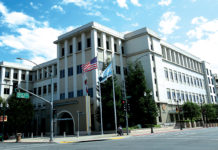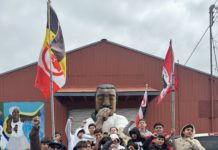I first heard the story in the 1970s when beginning my research on the history of the Chinese in the region. I read it in community histories, newspaper history columns, and both Chinese and non-Chinese old-timers told me the story with conviction.
It was true that Watsonville’s Chinatown moved from the corner of Maple and Union streets to a site across the Pajaro River in the summer of 1888. But the part about being driven out could not have been farther from the truth.
The Chinese were arguably the most vilified and disliked 19th century immigrants in California. I could add, ever. Anti-Chinese sentiment swept regularly through the state resulting in racist rhetoric, violence and restrictive legislation.
The City of Santa Cruz was one of California’s anti-Chinese epicenters. Crowds of Santa Cruzans chanting “The Chinese Must Go” were common in the 1870s and early 1880s. Santa Cruz had a small Chinatown, but the Chinese were not a critical part of its manufacturing economy. Their anti-Chinese position was an easy one to take.
Watsonville’s economy, however, was growing increasingly dependent on Chinese farm laborers, and as Pajaro Valley agriculture diversified, the Chinese became more important.
Santa Cruz chided Watsonville for this weakness on the “Chinese issue” and explanations of the importance of the Chinese to the Pajaro Valley economy fell on deaf ears.
Then, in 1887, change came to the Pajaro Valley.
After being thrown out (literally) of the Hawaiian cane sugar industry, Claus Spreckels trolled an offer of a huge beet sugar factory around California. Spreckels vowed to show those Hawaiians a thing or two about sugar.
To have Spreckels’ factory, the successful community had to provide a free site as well as a guaranteed 2,500 acres of beets to feed it. Watsonville and Salinas were the final two competitors and in December 1887, Watsonville won.
Spreckels would provide the capital and hardware for the Pajaro Valley’s new sugar industry, and farmers the land on which to grow the beets. But the beets required delicate thinning with the laborers crawling through the rows, often leaving a trail of blood from scraped knees behind.
Watsonville’s Chinatown had already outgrown the summer influx of Chinese to work in the strawberries and hops, but the potential of hundreds more beet workers would overwhelm the small corner Chinese service center.
So, Watsonville needed to relocate its Chinatown, and in early 1888 a group of prominent businessmen met with Chinese leaders to begin exploring the possible new location. Note, that they sat down as equals.
This was a big deal. The factory was already under construction, and beets were in the ground and growing. Making room for the Chinese beet workers was the last major puzzle piece and the Chinese leadership understood the leverage they had.
John T. Porter, prominent farmer and landowner owned the land and buildings on the corner of Maple and Union, and became the go-between in the negotiations. Porter also owned a large part of the riverside property across the river on which his personal home was located.
Porter offered the Monterey County site and offered to move the downtown Chinatown across the river and align the buildings neatly on both sides of a street. After some further negotiations, he sweetened the deal with three months free rent.
Before they accepted the deal, the Chinese leaders requested that it be reviewed. So, the most influential leaders of the Chinese in California came down from San Francisco to review what the Watsonville Chinese were being offered. The delegation included not only the head of the Chinese Six Companies, but also the representative of the Chinese Imperial government, Vice Consul F.A. Bee. Vice Consul Bee was on the job for five years, living in San Francisco and had never been outside that city.
After touring the site of the original Chinatown and the one proposed across the river, the delegation gave their approval to the deal and went back to San Francisco.
As far as I have been able to determine after a half-century of research, this visit by the California Chinese leadership outside San Francisco was unprecedented in the 19th century.
In Part 2 of this series, we will explore how and why the myth that Watsonville drove the Chinese as well as give a glimpse of the “Brooklyn Chinatown” across the river.
Historian Sandy Lydon taught at Cabrillo College for more than 50 years. You can find the above story in much greater detail in his award-winning book, “Chinese Gold: The Chinese in the Monterey Bay Region.”












Thank You for sharing this history,I look forward to Your next article..